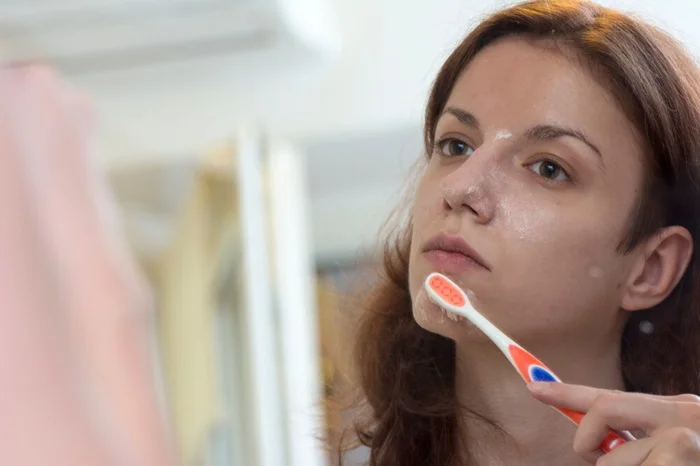Acne is a common skin condition that affects millions of people worldwide. While there are numerous treatments available, some individuals resort to unconventional methods to manage their breakouts. One such method involves the application of toothpaste to pimples, a practice that has gained popularity over the years. This article explores the rationale behind using toothpaste for acne treatment, the ingredients responsible for its drying effect, and the potential risks associated with this home remedy.
The Myth of Toothpaste as an Acne Treatment
Historical Context
The idea of using toothpaste on pimples likely originated from the belief that certain ingredients in toothpaste could effectively dry out acne. Many people have anecdotal evidence suggesting that applying toothpaste can lead to a reduction in pimple size and redness overnight. However, dermatologists warn against this practice, emphasizing that while some components may have drying properties, they can also cause irritation and worsen the skin condition.
Ingredients in Toothpaste
To understand how toothpaste might dry out pimples, it is essential to examine its common ingredients. The following substances are frequently found in toothpaste:
Calcium Carbonate: This ingredient acts as an abrasive and can absorb excess oil from the skin, potentially leading to a drying effect on pimples.
Baking Soda: Known for its absorbent properties, baking soda can draw moisture away from the skin and help cleanse pores.
Hydrogen Peroxide: Often included for its antibacterial properties, hydrogen peroxide can also contribute to drying out pimples but may irritate sensitive skin.
Alcohol: This ingredient is a common solvent in many toothpaste formulations and can lead to excessive dryness when applied to the skin.
Triclosan: Previously used for its antibacterial properties, triclosan may have contributed to the belief that toothpaste could effectively combat acne.
While these ingredients may provide some temporary relief by drying out pimples, they are not specifically formulated for skincare and can lead to adverse effects.
How Toothpaste Affects Pimples
Mechanism of Action
When applied to a pimple, toothpaste may create a drying effect due to its active ingredients. This process typically occurs as follows:
Absorption of Oil: Ingredients like calcium carbonate and baking soda absorb excess oil from the pimple.
Reduction of Moisture: The drying agents work by removing moisture from the affected area, which can temporarily shrink the size of the pimple.
Inflammation Reduction: Some components may help reduce inflammation, leading to a decrease in redness.
Short-Term Benefits vs. Long-Term Risks
While some individuals may experience short-term benefits from using toothpaste on their pimples, such as reduced size and redness, these effects are often fleeting. Dermatologists caution that the long-term risks associated with this practice outweigh any potential benefits:
Skin Irritation: The harsh chemicals in toothpaste can irritate sensitive facial skin, leading to increased redness and discomfort.
Damage to Skin Barrier: Regular use of toothpaste on acne-prone skin can compromise the skin’s natural barrier, making it more susceptible to infections and further breakouts.
Worsening of Acne: In some cases, individuals may find that their acne worsens after using toothpaste due to irritation or allergic reactions.
Alternatives to Toothpaste for Acne Treatment
Given the potential drawbacks of using toothpaste on pimples, it is advisable to explore safer alternatives for acne treatment. Dermatologists recommend several over-the-counter options that are specifically designed for acne management:
1. Benzoyl Peroxide
Benzoyl peroxide is a widely used topical treatment that targets acne-causing bacteria while also helping to unclog pores. It works by introducing oxygen into the pores, which kills anaerobic bacteria responsible for acne formation.
2. Salicylic Acid
Salicylic acid is another effective ingredient commonly found in acne treatments. It helps exfoliate the skin and unclog pores by dissolving dead skin cells and excess oil.
3. Retinoids
Topical retinoids promote cell turnover and prevent clogged pores by encouraging new skin cell growth. They are effective in treating both inflammatory and non-inflammatory acne.
4. Tea Tree Oil
For those seeking natural remedies, tea tree oil has been shown to possess antimicrobial properties that can help reduce acne lesions without causing excessive dryness.
5. Non-Comedogenic Moisturizers
Using non-comedogenic moisturizers can help maintain skin hydration without clogging pores. Keeping the skin adequately moisturized is crucial for overall skin health.
Conclusion
While the idea of using toothpaste as a quick fix for pimples may seem appealing due to its drying properties, it is essential to recognize the potential risks involved. The harsh ingredients found in toothpaste can lead to irritation, damage to the skin barrier, and even worsen acne over time. Instead of relying on this home remedy, individuals should consider safer alternatives specifically designed for acne treatment.
By opting for dermatologist-recommended products such as benzoyl peroxide or salicylic acid, individuals can effectively manage their acne while minimizing the risk of irritation or adverse effects. Ultimately, maintaining a consistent skincare routine tailored to individual needs will yield better results than resorting to unconventional methods like applying toothpaste on pimples.
In summary, while some ingredients in toothpaste may dry out pimples temporarily, it is not a recommended or effective long-term solution for managing acne.
Related topic:
Should I Do Skincare Before Or After Shower?
How Do You Take Care Of A Boil At Home?
What To Use After Dermaplaning At Home?

